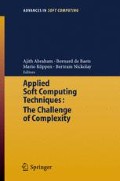Abstract
Most of the classical clustering algorithms are strongly dependent on, and sensitive to, parameters such as number of expected clusters and resolution level. To overcome this drawback, a Genetic Programming framework, capable of performing an automatic data clustering, is presented. Moreover, a novel way of representing clusters which provides intelligible information on patterns is introduced together with an innovative clustering process. The effectiveness of the implemented partitioning system is estimated on a medical domain by means of evaluation indices.
Access this chapter
Tax calculation will be finalised at checkout
Purchases are for personal use only
Preview
Unable to display preview. Download preview PDF.
References
Fayyad U M, Piatetsky-Shapiro G, Smith P (1996) From data mining to knowledge discovery: an overview. In: Fayyad U M et al. (eds) Advances in knowledge discovery and data mining. AAAI/MIT Press, 1–34
Hand D J, Mannila H, Smyth P (1988) Principles of data mining. MIT Press
Han J, Kamber M 2001) Data mining: concepts and techniques. Morgan Kaufmann
Zhang T, Ramakrishnan R, Livny M. (1996) BIRCH: an efficient data clustering method for very large databases. Proceedings of the ACM SIGMOD Int. Conf. on Management of Data, 103–114
Guha S, Rastogi R, Shim K (1998) CURE: an efficient clustering algorithm for large databases. Proceedings of the ACM SIGMOD Int. Conf. on Management of Data, 73–84
Aggarwal C, Yu P S (2000) Finding generalized projected clusters in high dimensional spaces. Proceedings of the ACM SIGMOD Int. Conf. on Management of Data, 70–81
Bock H H (1996) Probability models in partitional cluster analysis. In: Ferligoj A, Kramberger A (eds) Developments in data analysis, 3–25
Fraley C, Raftery A (1998) How many clusters? Which clustering method? Answers via model–based cluster analysis. The Computer Journal 41 (8): 578–588
Lee C Y, Antonsson E K (2000) Dynamic partitional clustering using evolutionary strategies. Proceedings of the 3rd Asia–Pacific Conference on Simulated Evolution and Learning. IEEE Press, Nagoya, Japan
Jain A K, Murty M N, Flynn P J (1999) Data clustering: a review. ACM Computing Surveys 31 (3): 264–323
Hall L O, Ozyurt B, Bezdek J C (1999) Clustering with a genetically optimized approach. IEEE Trans, on Evolutionary Computation 3(2):103–112
Sarafis I, Zalzala A M S, Trinder P W (2002) A genetic rule–based data clustering toolkit. Proceedings of the IEEE Congress on Evolutionary Computation, 1238–1243. Honolulu, Hawaii, USA
Cristofor D, Simovici D A (2002) An information–theoretical approach to clustering categorical databases using genetic algorithms. Proceedings of the Second SIAM International Conference on Data Mining, 37–46. Washington
Babu G P, Marty M N (1994) Clustering with evolutionary strategies Pattern Recognition 27(2): 321–329
Koza J R (1992) Genetic Programming: on programming computers by means of natural selection and genetics. The MIT Press, Cambridge, MA
Yip A M (2002) A scale dependent data clustering model by direct maximization of homogeneity and separation. Proceedings of the Mathematical challenges in scientific data mining IPAM, 14–18 January, www.ipam.ucla.edu/publications/sdm2002/sdm2002_ayip.pdf
Murphy P M, Aha D W UCI Repository of machine learning databases. University of California, Department of Information and Computer Science, www.ics.uci.edu/~mlearn/MLRepository.html
Author information
Authors and Affiliations
Editor information
Editors and Affiliations
Rights and permissions
Copyright information
© 2006 Springer
About this paper
Cite this paper
De Falco, I., Tarantino, E., Cioppa, A., Fontanella, F. (2006). An Innovative Approach to Genetic Programming—based Clustering. In: Abraham, A., de Baets, B., Köppen, M., Nickolay, B. (eds) Applied Soft Computing Technologies: The Challenge of Complexity. Advances in Soft Computing, vol 34. Springer, Berlin, Heidelberg. https://doi.org/10.1007/3-540-31662-0_4
Download citation
DOI: https://doi.org/10.1007/3-540-31662-0_4
Publisher Name: Springer, Berlin, Heidelberg
Print ISBN: 978-3-540-31649-7
Online ISBN: 978-3-540-31662-6
eBook Packages: EngineeringEngineering (R0)

